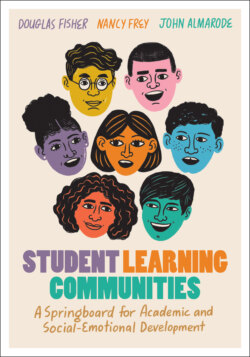Читать книгу Student Learning Communities - Нэнси Фрей - Страница 23
На сайте Литреса книга снята с продажи.
Plan for Productive Failure
ОглавлениеFailure is underrated. Now, before you close this book in disgust, let us explain. We are not suggesting you present students with a task that is so difficult that they immediately give up. We're saying that a task that offers a challenge or a problem to solve makes deep learning possible. It's the wrestling with a task that causes students to rely on one another. A spirit of community can bloom when a group collectively faces a complex challenge. This joint attention to a problem generates solutions for that problem—a clear result. It's also a way to help students build valuable social-emotional skills like persistence, resilience, and determination.
Take a moment to imagine yourself stuck in a massive traffic jam on a freeway. To make matters worse, your lane is ending, and cars are jockeying for position as they squeeze over to complete the merge. Chances are, you are either a "lineupper" or a "sidezoomer" (Gorney, 2008). The lineuppers are patiently waiting their turn; typically, they don't want to let those rude sidezoomers into the lane. The sidezoomers, on the other hand, are utilizing the available space to get ahead, never mind the line. So, who's right? The answer, it turns out, is that the traffic flows most smoothly when the lineuppers and the sidezoomers work cooperatively, with a minimum of braking and speeding up, to ensure that everyone gets in the lane. Think of rice moving smoothly through a funnel. Tom Vanderbilt, author of Traffic: Why We Drive the Way We Do (2009), makes this point: ants never get into traffic jams.
What's this got to do with failure and student learning communities? Everything, if you view the issue of merging lanes as a problem, but the kind of problem that isn't likely to result in utter defeat. When the traffic's moving along just fine, you really don't notice your fellow drivers. But when the merge lane looms ahead, you start paying closer attention to them. The best result occurs when everyone cooperates to get the job done. This principle has been confirmed by both traffic engineers and queuing theorists (who knew there was such a job?).
Even though most of us have not formally researched queuing theory, we nonetheless understand its principles. You have been stuck in traffic, and you've either been the patient/indignant lineupper or the assertive sidezoomer. At some point, you've probably also witnessed, experienced, or read about the failure of effectively queuing—accidents, horn honking, road rage. The solution, cooperative queuing, makes sense to you precisely because you have faced the problem before. You've learned, after all the trial and error of experience, what the best way really is.
Now, let's talk about how failure plays an important role in learning. To learn collaboratively, students need to be presented with a problem that might result in an incorrect answer, a failed experiment, or an inaccurate conclusion. If success is guaranteed, learning is impossible. Collaborative learning occurs when students recognize they've got a challenge to tackle and are ready to do so. There is an entire research base on the importance of productive failure as an essential element of productive group learning. When the task is structured so that it is complex but not impossible, learners outperform those in groups that have tasks that ensure success (Kapur, 2016).
